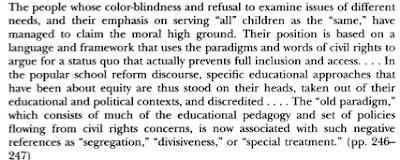Walker, A., Shafer, J., & Liam, M. (2004) “Not in My Classroom”: Teacher Attitudes Towards English Language Learners in the Mainstream Classroom. National Association for Bilingual Education Journal of Research and Practice, 2 (1), 130-160.
“Not in my classroom!” I shiver and cringe every time I hear the statement, especially when the statement concerns culturally and linguistically diverse students. In the article “’Not in My classroom’: Teacher Attitudes Towards English Language Learners in the Mainstream Classroom,” Anne Walker, Jill Shafer, and Michelle Liam surveyed 422 K-12 teachers and interviewed six English Language Learner (ELL) teachers about their attitudes concerning ELLs. Walker et al discovered an alarming amount of negative to neutral attitudes mainstream teachers held towards ELLs. Through their research, the authors uncovered a number of factors contributing to mainstream teachers’ negative and neutral attitudes; moreover, through their research, Walker et al question mainstream teachers’ ability to teach ELLs and, consequently, the broken inclusive ideology. Walker et al (2004) calls for the “professional development efforts in helping teachers effectively teach ELLs in an inclusive setting” (156), which requires comprehensive, appropriate, and long-term instruction.
In Walker et al’s research, the author identified five factors or themes that contribute to the teacher’s attitudes:
1. Time and Teacher Burden: Walker et al report many teachers feel overwhelmed with preexisting demands place upon them. Taking on demands concerning ELLs causes the survey teachers to fell like they have too much on his or her plate (Walker et al, 2004).
2. Lack of Training: “Estimated that 88% of K-12 teachers nationwide have no training in [English as a Second Language (ESL)]” (142), Walker et al find many teachers have a sense of failure, frustration, and ill preparedness when working with ELLs (Walker et al, 2004). However, the authors note teachers with little ESL training want ELLs in their class, acknowledges the need for diversity, and believes mainstream teachers need to accommodate ELLs instructional needs (Walker et al 2004).
3. The Influence of Negative Administrators Attitudes: In their article, the authors also discovered administrators’ negative attitudes to have a great amount of influence; for instance, a principal of a school deals with serious behavioral problems and when a principal holds a negative attitude towards ELLs, the negative view produces serious ethical issues. One example the authors give relates to free breakfast and speaking English. One school’s policy withheld the free federal breakfast from ELLs who were caught speaking their native language (Walker et al, 2004). Clearly, the negative attitudes of administrators have a shocking effect.
4. Malignant Misnomers about Effective ELL Education: Concerning this factor, Walker et al discuss various myths about effective ELL education. For instance, 15% of the teachers interviewed thought minimizing an ELL second language improved their English acquisition. In addition, 7% of the teachers surveyed believed ELL should be fluent in English after only one year of ELL instruction (Walker et al, 2004).
5. The Ideology of Common Sense: Alarmingly, the authors report 51% of the teachers had a resistance to their own professional development concerning the education of ELLs. Walker et al (2004) note survey comments like, “Teachers don’t need specialized ESL training; common sense and good intentions work fine” (145). Nevertheless, Walker et al (2004), citing Banks, Calderon & Carreon, and Morgan, state “most experts in ELL education would agree, common sense and good intentions are important in working with ELLs, but the complexity of the job requires a broad range of knowledge in second language acquisition, linguistics, multicultural education and ELL pedagogy” (146).
In “Not in My Classroom,” Walker et al have noted an alarming mind set in teachers survey in their study. The authors point to the myths and misconceptions of ELL education as having a perversely effect on teachers. In their study, the negative attitudes do alarm Walker et al; however, it is the neutral attitudes that truly frighten them. If the negative views of teachers spawned from the five factors or themes mentioned above, then Walker et al worry teachers with neutral attitudes will fall into a negative mindset. As stated above, Walker et al mainstream teachers need professional development in comprehensive, appropriate, and long-term ELL instruction for an inclusive model to work (Walker et al, 2004); however, they are worried the changed need in ELL instruction will come too late for many ELLs.

